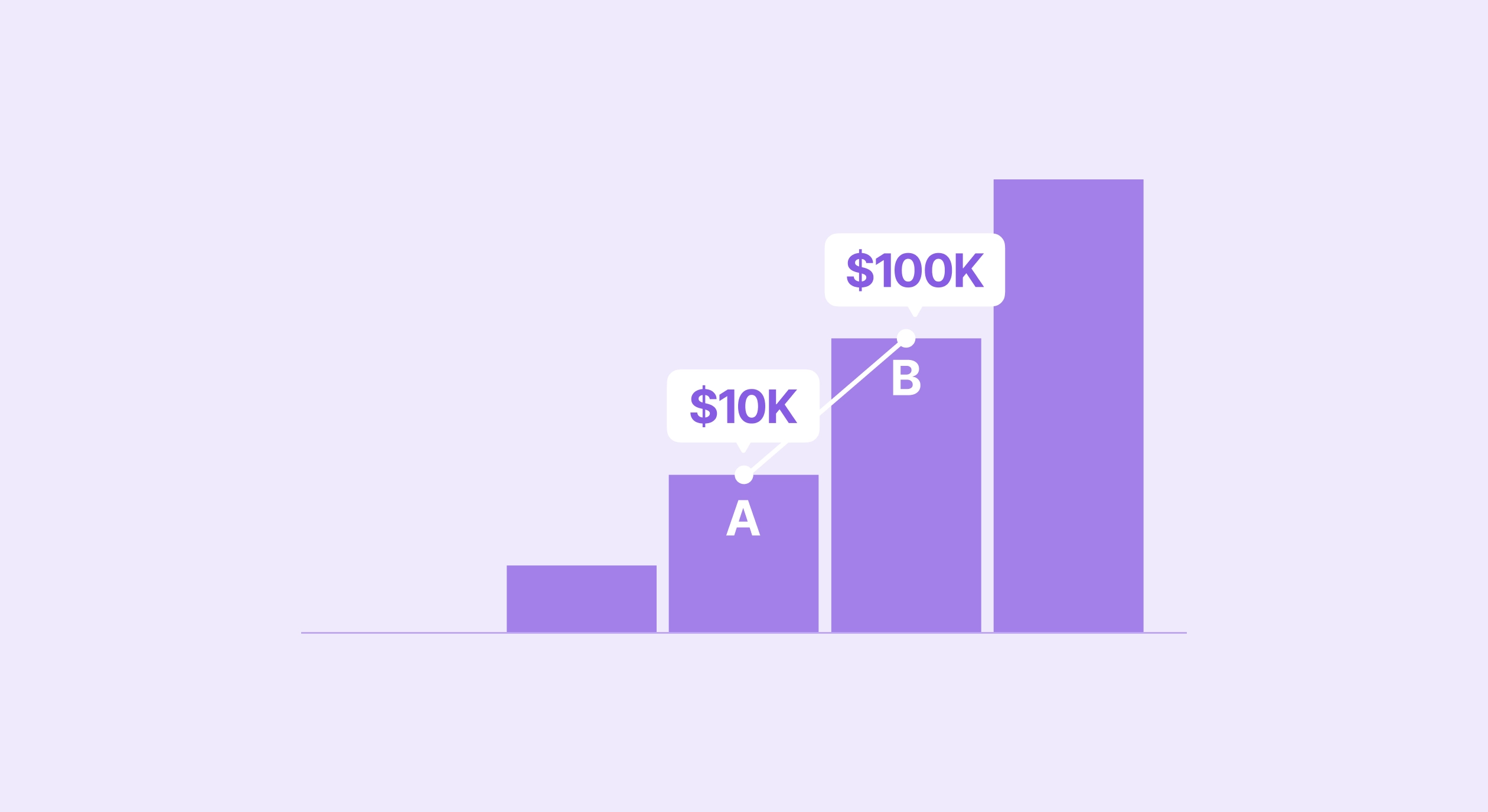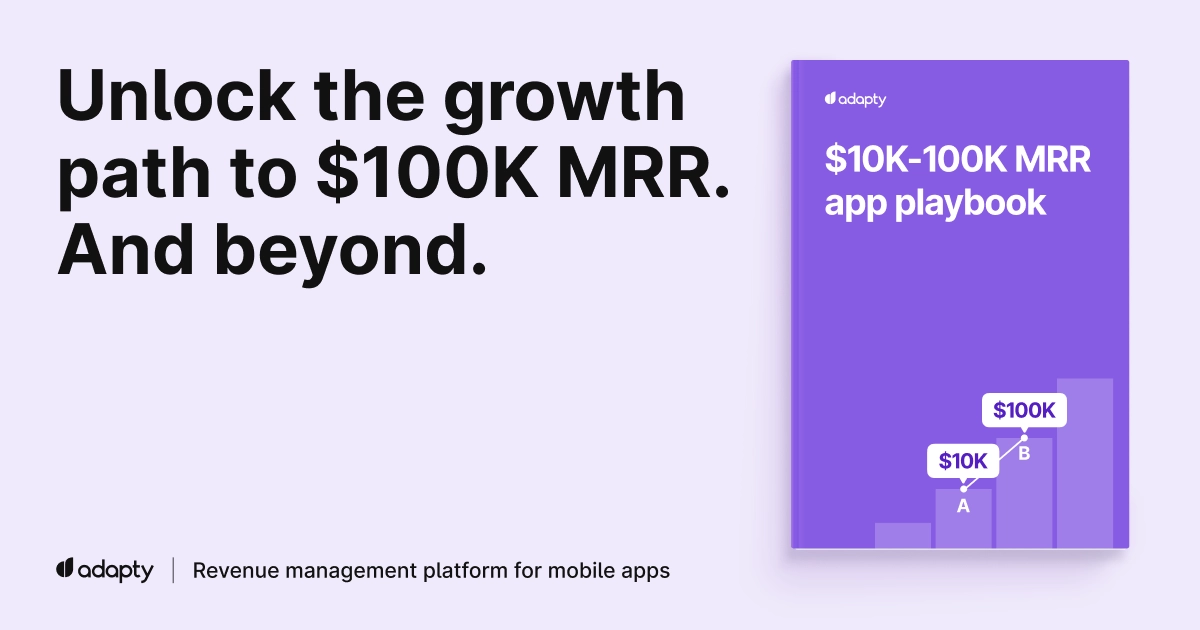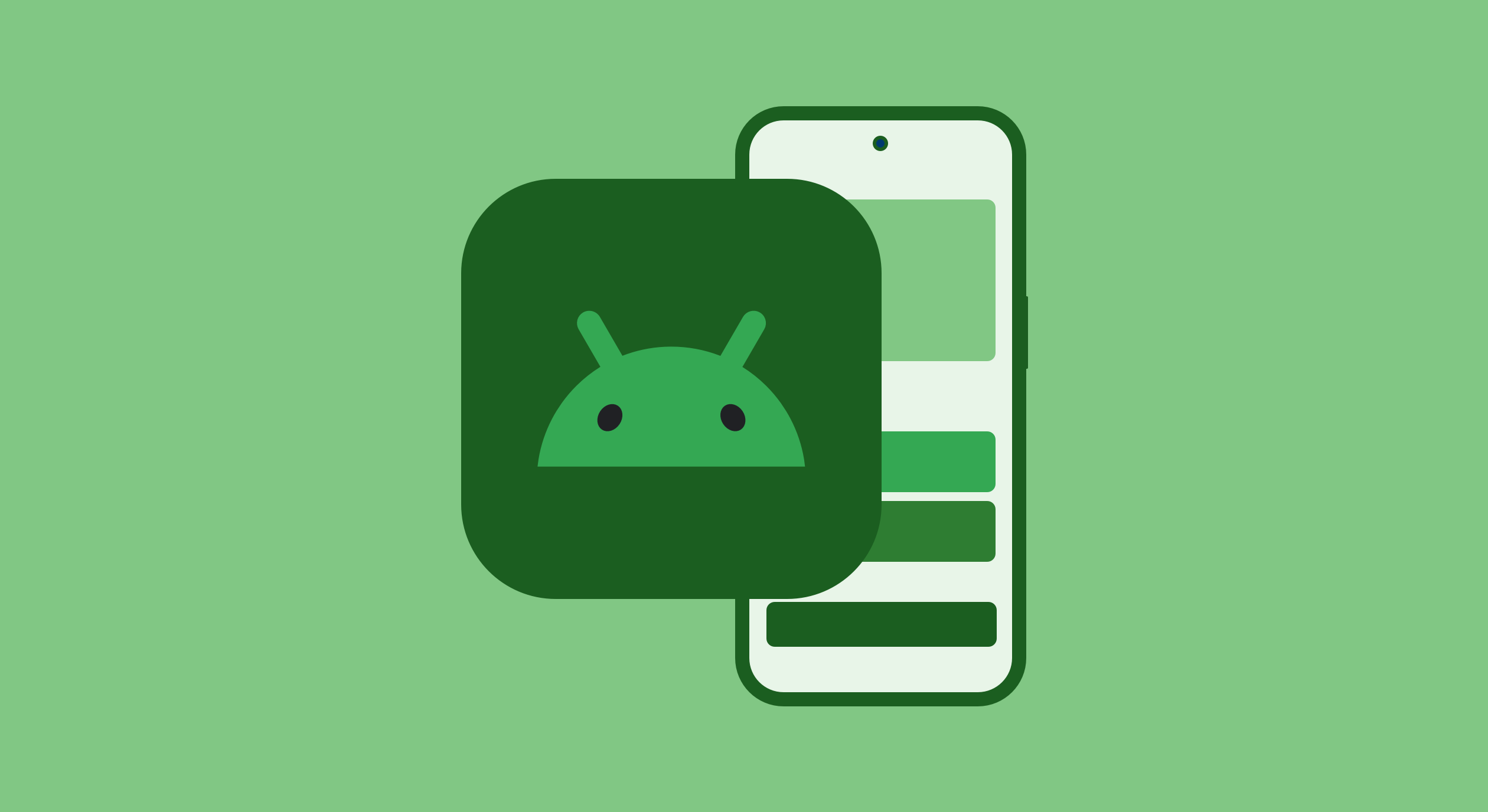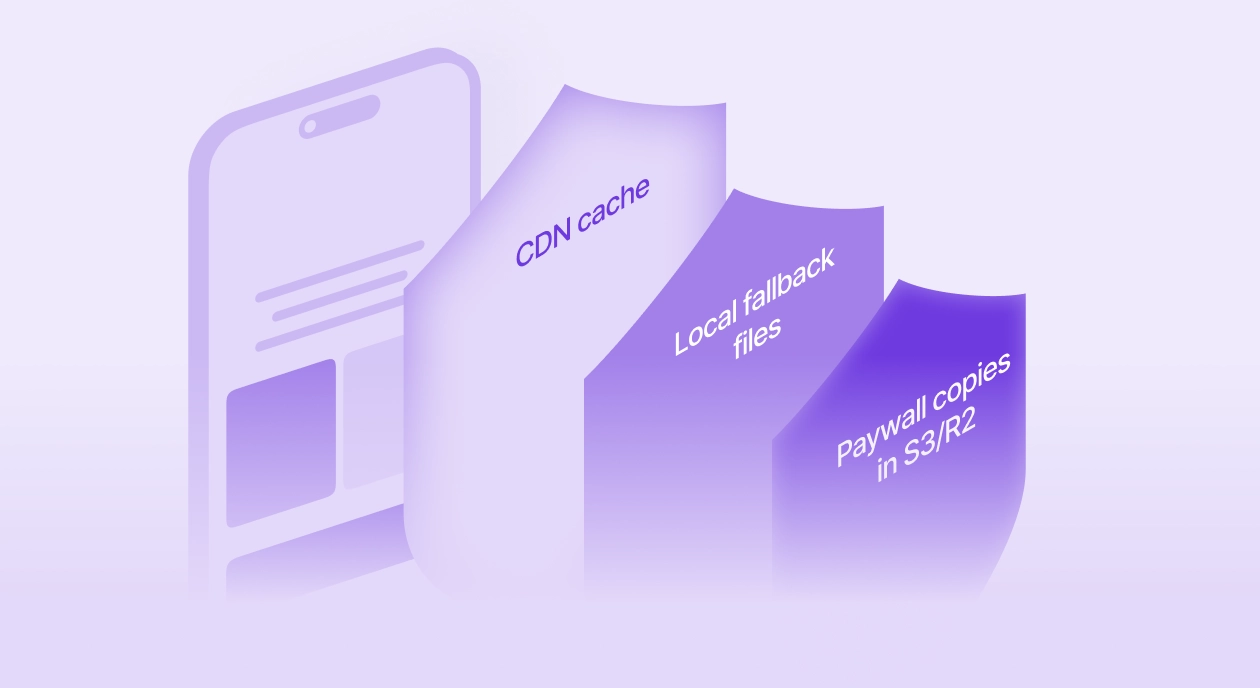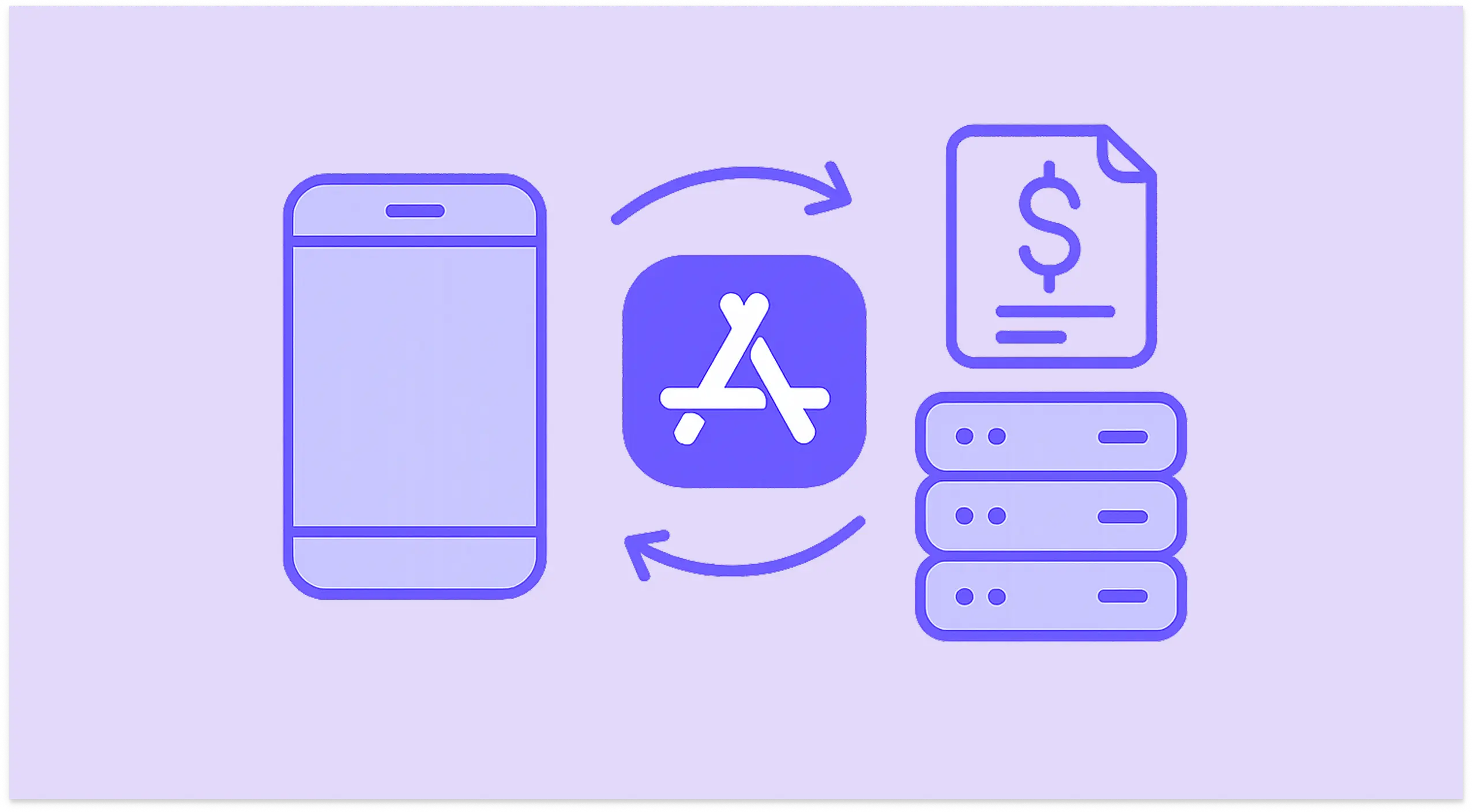Most subscription apps hit a wall at $10K monthly recurring revenue. Growth stalls. Acquisition channels saturate. The tactics that worked early no longer work.
Getting to $100K MRR requires a fundamental shift from hustle to systems, from guessing to measuring, from scattered efforts to coordinated execution.
We’ve put together seven key questions (and answers to them) that help acquire the systematic way of thinking that unlocks continuous growth. Let’s break them down.
How to set up app analytics right?
User acquisition metrics live in ad platforms. Revenue sits in spreadsheets. Product behavior exists in separate analytics tools. The problem is that these three areas constantly influence each other.
Connect three core layers:
- UA analytics (CPI, CTR, CPM) show how marketing spend converts into users
- Monetization analytics (MRR, CAC, LTV) reveal how those users generate revenue and how effective UA is compared to your earnings
- Product analytics (retention, funnel conversion, feature adoption) track behavior that drives retention and conversion
Start simple. Pull data from ad managers and app store consoles manually. As you grow, add a Mobile Measurement Partner solution to track traffic attribution. By $100K MRR, centralize everything in a BI system where all three layers connect in real time.
Better retention increases LTV, giving you room to bid higher on acquisition. Higher-quality traffic converts better. A strong product creates organic growth. These connections only become visible when you track everything together.
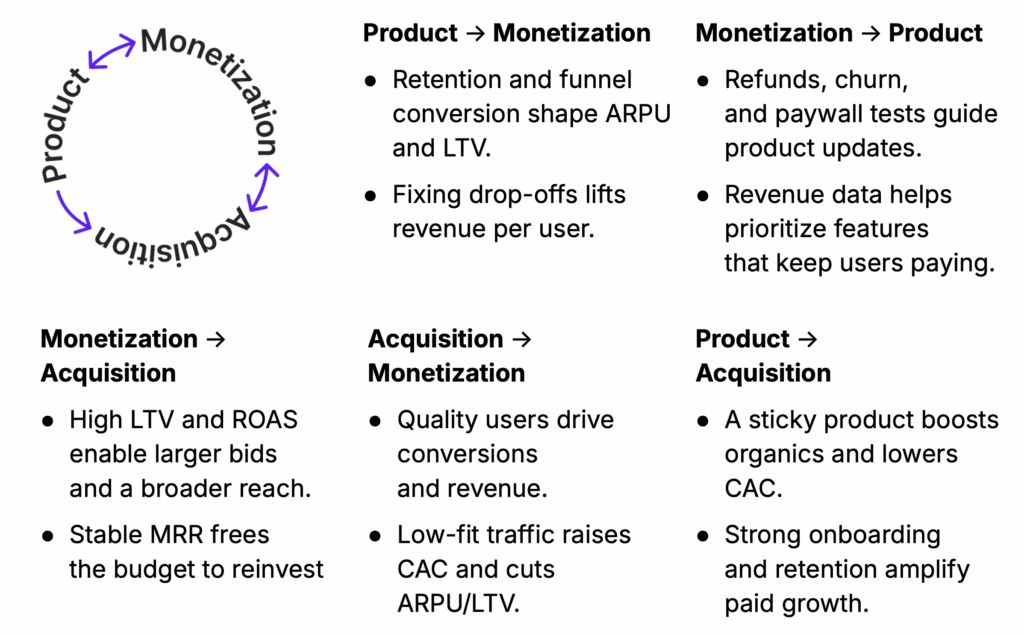
There is no one-fits-all solution for every team, but having a unified view is what matters most.
When and how to start paid ads for a mobile app?
Most apps hit organic growth ceilings around $10K MRR. That’s when paid acquisition becomes necessary. But jumping in unprepared burns cash quickly.
First, you need to determine how suited your app is for paid channels.
- Thanks to higher LTV and retention, health & fitness apps, productivity tools, and education apps, among others, typically work well.
- Utility apps (scanners, cleaners, file managers), niche content, and one-time purchases may struggle.
The deciding factor is LTV. Calculate your 12-month lifetime value and divide by two. That’s your maximum sustainable acquisition cost (CAC). If the math doesn’t yet work, focus on improving retention and revenue per user before spending on ads.
💡 Newer apps may not have enough data to calculate LTV reliably. Use our LTV Prediction Calculator to get approximate numbers.
When you’re confident in your ability to acquire users in paid channels with profit, start with one channel. Meta Ads is where most apps begin because it offers massive reach and a straightforward setup.
Next, you need to budget right. Running below $50 daily slows algorithm learning. Start at $100 to $200 daily with at least 15 creative variations — the more, the better. Monitor for 3 to 5 days, then shift budget to top performers.
Start scaling budgets when unit economics prove positive. And remember to refresh creatives every 2 to 3 weeks to avoid ad fatigue and keep UA metrics reasonable.
How to produce low-cost and effective ad creatives?
Most creatives fail. And even successful ads lose relevance within 2 to 4 weeks. When audiences tire of seeing the same ad, engagement drops, platforms reduce delivery, and your return on ad spend falls.
Fresh content resets the cycle. That’s why you’ll need a constant stream of new creatives.
For first experiments with paid channels, start with static ones. Images and carousels are fast and cheap to test. When a static version shows promise, upgrade to video. UGC videos work particularly well on TikTok because they feel native.
Your rotation schedule depends on spending level:
- High spend ($500+ daily): introduce new creatives every 7–10 days
- Lower spend ($100–$200 daily): refresh every 2–3 weeks
Watch your click-through rate. A 20 to 40 percent drop signals it’s time to refresh.
Study competitors for inspiration. Use Meta Ad Library to find active ads. Check TikTok’s Top Ads page for your category. Borrow what works and test variations.
AI is a good way to test new formats and hypotheses at a low cost, especially at early stages. Use it to generate ideas, visuals, voiceovers, and short videos for quick validation. Once a concept proves effective, rebuild it with real people or higher-quality footage to maximize performance.
As you grow, your production needs scale. We are breaking down different levels of setup this way:
| Level | MRR Range | Setup | Description | Cost Focus |
|---|---|---|---|---|
| 1. Going solo | <$15K | DIY | Use AI for ideas, static images, and simple videos. Shoot basic UGC yourself. Great for early testing. | Time |
| 2. Freelancers | <$50K | In-house strategy + outsourced production | Hire creators from marketplaces ($150–300/video) or freelancers (~$50/video). Quality varies, so write clear briefs. | Per-video fees |
| 3. Agency | <$100K | Outsourced production | Let a creative shop handle volume. You focus on testing and UA. Faster delivery, less control. | A few thousand $/month |
| 4. In-house team | <$500K | Internal production | Build your own team for speed, feedback, and brand control. Higher cost but better performance. | Salaries + tools |
| 5. In-house + agencies | >$500K | Hybrid | Combine internal team with multiple agencies for variety and scale. High resource demand but maximum output. | Mixed (high) |
How do tests help grow an app’s revenue?
Most subscriptions happen during or immediately after onboarding. This is your strongest lever for converting new users into paying customers.
Both the onboarding flow and the paywall help convince a user to convert. Even the smallest details may impact their decision. Here’s what to test on paywalls to find the best combination of elements:
- Price points and plan mix across weekly, monthly, and annual.
- Trial presence and length; messaging around cancellation.
- Layout and defaults: clear comparison, best‑value highlight, confident CTA.
- Timing: end of onboarding, after a meaningful action, and later sessions.
Find a full list of paywall test ideas here.
Onboarding elements matter equally. Number of screens, personalization, visual design, copy, signup friction, and social proof all impact whether users convert. Here are the key levers:
- Sequence length that matches complexity and reduces uncertainty.
- Light personalization via goals or a short quiz.
- Friction management: login via socials or “try first” paths where possible.
- Micro‑moments: progress, small wins, and supportive visuals.
Set metrics before testing. Your primary targets are LTV and ARPU. Since these take months to reflect changes, use proxy metrics that predict long-term impact: trial conversion rates, onboarding completion, Day 1 retention, and user engagement ratios.
Run single-variable A/B tests: if you test several elements at once, you won’t know what caused the change.
When should you expand into new paid channels for your app?
To accelerate growth, apps eventually start new ad channels. Remember: do it only if your current channel is profitable and stable.
Adding channels won’t fix slowing growth. If your MRR is flat, CPIs are rising, and click-through rates are dropping, the issue lies in your funnel or creatives, not missing platforms.
Your signal to expand isn’t reaching a revenue milestone. It’s when your unit economics become predictable: consistent positive return on ad spend, customer acquisition cost lower than lifetime value, and retention holding steady.
We’ve already covered Meta, so here are the essentials about other channels:
- TikTok: UGC‑first scripts and quick storytelling; video-heavy.
- Apple Search Ads: high‑intent traffic; optimize store assets and CPP usage.
- Google App Campaigns: broad reach; feed strong conversion signals.
New channels serve to reduce platform dependency, diversify reach, and smooth seasonality. Each platform has different audience sizes, creative rules, and performance characteristics. So, master one before adding another.
How and when to launch an app in new markets?
Another leap of growth is to expand to new markets. Most apps start in Tier 1 English markets where iOS spend is high, but growth eventually stabilizes.
Only expand when your current market generates predictable unit economics. Test one new market at a time with a small budget.
- Run a soft launch with $2K to $5K over 2 to 4 weeks using channels that already perform.
- Localize only what drives revenue: your app store page, onboarding copy, and paywall pricing.
- Skip translating everything else initially.
When choosing your next market, start by spotting early signals. For example, regions where your app gains downloads even without localization. Then, evaluate the market’s potential based on economic factors. Here’s the average 12-month LTV by country, per Adapty data:
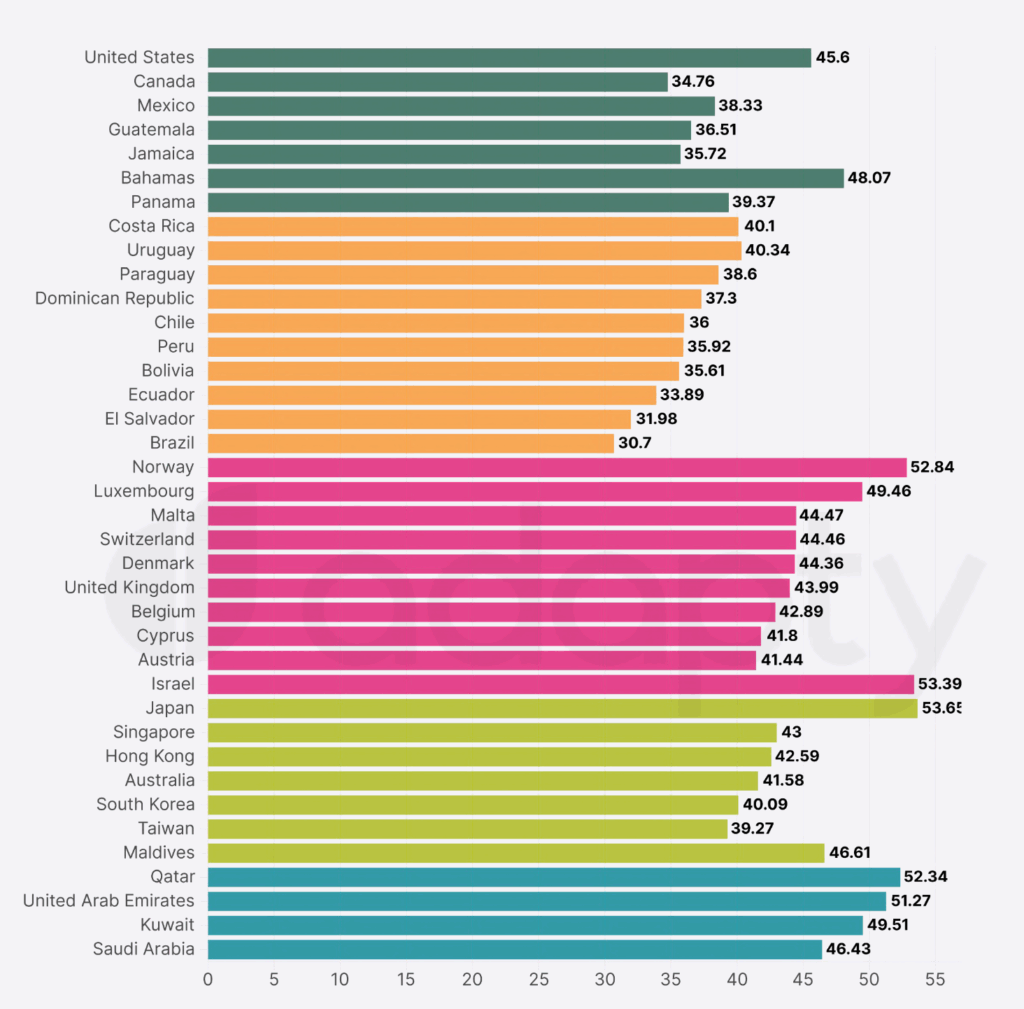
After the test, evaluate three metrics: LTV compared to customer acquisition cost (aim for at least 2x), trial to paid conversion (within 10 percent of your core market), and Day 30 retention (in line with your best markets). If two out of three look solid, continue. Otherwise, pause and diagnose.
Where to get funding to fuel app growth?
Whether you need external funding depends on your ambitions and competitive landscape.
First thing to know is that ad platforms offer deferred payments, meaning you have 30 days to pay the invoice for ads. This delay can be helpful for fast-growing apps, but it’s not the same as real financing.
For easier navigation, we put all viable options in this table:
| Deferred payments (Ad platforms) | Factoring | Revenue- based financing | VC / Angel investment | |
| Pros | Smooths cash flow | Immediate cash, non-dilutive | More capital, flexible payback | Large funds + support |
| Cons | Not real funding (no extra cash) | Advance < payout | Costlier than factoring | Dilution, high expectations |
| Cost | No fee (if on time) | Low single-digit fees | ~1.1×–1.5× repay cap | 15–25% equity |
| Speed | Days-weeks setup | Days after setup | Days after setup | Angels: weeks; VCs: months |
| Best for | Fast-scaling UA spenders | $20K–50K MRR apps | $50K+ MRR with steady growth | Exceptional apps needing rapid scale |
💡 For most apps, VC funding isn’t realistic. Angel investors are more flexible with smaller apps.
Choose funding that matches your growth stage without compromising control unnecessarily.
Your growth checklist
The strategy comes down to these simple rules:
— Use analytics as your compass. Eliminate blind spots and build a reliable setup, even if it starts simple.
— Start small with paid campaigns. Focus on one channel first. Test with a reasonable budget, find the winning creatives, and scale them.
— Prioritize creative volume. More creatives mean more chances to find what works. Learn from competitors and leverage AI to speed up production.
— Test systematically. Begin with paywall elements and placements, then experiment with onboarding flows. Change one element at a time to track results accurately.
— Master one channel before adding another. Don’t expand to fix performance issues.
— Validate new markets organically. Look for early signals before investing in paid growth.
— Plan your financing thoughtfully. Explore options like factoring, revenue-based financing, or investors based on your ambitions and current performance.
For a deeper look into how to reach $100K MRR for your app, download our full ebook.
FAQ
Most apps hit an organic growth ceiling around $10K MRR. That’s when paid acquisition starts making sense. Begin small with one channel like Meta Ads, test multiple creatives, and scale once you see positive unit economics.
